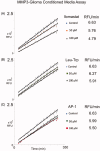Examination of sulfonamide-based inhibitors of MMP3 using the conditioned media of invasive glioma cells
- PMID: 32156166
- PMCID: PMC7144313
- DOI: 10.1080/14756366.2020.1715387
Examination of sulfonamide-based inhibitors of MMP3 using the conditioned media of invasive glioma cells
Abstract
Glioblastoma multiforme (GBM) is the deadliest and the most common primary malignant brain tumour. The median survival for patients with GBM is around one year due to the nature of glioma cells to diffusely invade that make the complete surgical resection of tumours difficult. Based upon the connexin43 (Cx43) model of glioma migration we have developed a computational framework to evaluate MMP inhibition in materials relevant to GBM. Using the ilomastat Leu-Trp backbone, we have synthesised novel sulphonamides and monitored the performance of these compounds in conditioned media expressing MMP3. From the results discussed herein we demonstrate the performance of sulfonamide based MMPIs included AP-3, AP-6, and AP-7.
Keywords: Matrix metalloproteinase; glioblastoma multiforme; ilomastat; inhibition.
Conflict of interest statement
The authors declare that there is no conflict of interest regarding the publication of this paper.
Figures





Similar articles
-
Discovery of dehydroabietic acid sulfonamide based derivatives as selective matrix metalloproteinases inactivators that inhibit cell migration and proliferation.Eur J Med Chem. 2017 Sep 29;138:979-992. doi: 10.1016/j.ejmech.2017.07.020. Epub 2017 Jul 13. Eur J Med Chem. 2017. PMID: 28756264
-
Synthesis, Biological Evaluation, and Docking of Dihydropyrazole Sulfonamide Containing 2-hydroxyphenyl Moiety: A Series of Novel MMP-2 Inhibitors.Chem Biol Drug Des. 2015 Dec;86(6):1405-10. doi: 10.1111/cbdd.12604. Epub 2015 Jul 14. Chem Biol Drug Des. 2015. PMID: 26061284
-
Sulfonamide derivatives containing dihydropyrazole moieties selectively and potently inhibit MMP-2/MMP-9: Design, synthesis, inhibitory activity and 3D-QSAR analysis.Bioorg Med Chem Lett. 2015 Oct 15;25(20):4664-71. doi: 10.1016/j.bmcl.2015.08.026. Epub 2015 Aug 14. Bioorg Med Chem Lett. 2015. PMID: 26346367
-
Ligand-based design of anticancer MMP2 inhibitors: a review.Future Med Chem. 2021 Nov;13(22):1987-2013. doi: 10.4155/fmc-2021-0262. Epub 2021 Oct 12. Future Med Chem. 2021. PMID: 34634916 Review.
-
Targeting nitric oxide and NMDA receptor-associated pathways in treatment of high grade glial tumors. Hypotheses for nitro-memantine and nitrones.Nitric Oxide. 2018 Sep 1;79:68-83. doi: 10.1016/j.niox.2017.10.001. Epub 2017 Oct 13. Nitric Oxide. 2018. PMID: 29030124 Review.
Cited by
-
Bibliometric analysis and visualization of Connexin 43 in the field of solid tumor research(2000-2024).Front Immunol. 2025 May 9;16:1588828. doi: 10.3389/fimmu.2025.1588828. eCollection 2025. Front Immunol. 2025. PMID: 40416989 Free PMC article.
-
Integrated Network Discovery Using Multi-Proteomic Data.Methods Mol Biol. 2022;2456:173-183. doi: 10.1007/978-1-0716-2124-0_12. Methods Mol Biol. 2022. PMID: 35612742
-
Immunohistochemical Characterisation of GLUT1, MMP3 and NRF2 in Osteosarcoma.Front Vet Sci. 2021 Aug 3;8:704598. doi: 10.3389/fvets.2021.704598. eCollection 2021. Front Vet Sci. 2021. PMID: 34414229 Free PMC article.
References
-
- Legler JM, Ries LAG, Smith MA, et al. . Brain and other central nervous system cancers: recent trends in incidence and mortality. JNCI-J Natl Cancer Inst 1999;91:1382–90. - PubMed
-
- Roth W, Isenmann S, Nakamura M, et al. . Soluble decoy receptor 3 is expressed by malignant gliomas and suppresses CD95 ligand-induced apoptosis and chemotaxis. Cancer Res. 2001;61:2759–65. - PubMed
-
- Furnari FB, Fenton T, Bachoo RM, et al. . Malignant astrocytic glioma: genetics, biology, and paths to treatment. Genes Dev 2007;21:2683–710. - PubMed
MeSH terms
Substances
LinkOut - more resources
Full Text Sources
Other Literature Sources
Medical
Miscellaneous
